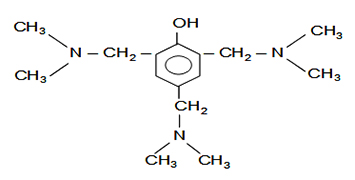
Phone No. : +91-982 0373 895
Email id : kavita.kamble@paladinchemicals.com

Phone No. : +91-982 0373 895
Email id : kavita.kamble@paladinchemicals.com





PCAT - 1030 is tris-(dimethyl-aminomethyl) phenol, a technical grade curing agent. It is Lewis Base catalyst, works to boost the curing mechanism of epoxy resin. It activates the reaction of epoxy resin with polyamide, their adducts, amidoamines, amine adducts, phenalkamines & phenalkamides etc., It also helps to activate the reaction between epoxy polysulphides, various aliphatic acids & anhydrides. Generally, it is also use to catalyse & accelerate reaction between polyols / isocynates & tzimerization of isocynates.
 Chemical Structure :
Chemical Structure :

Novel Features :

Applications :
Accelerator for Epoxy systems for end uses like
Typical Properties :
Sr. No. |
Property | Unit | Specification |
| 1 | Appearance | Visual | Redish brown liquid |
| 2 | Colour | Gardner | <8 |
| 3 | Odour | -- | Odour of amine |
| 4 | Viscosity @25° C | cPs | 200 - 500 |
| 5 | Flash Point ( Closed Cup ) | °C / °F | 140° / 284° |
| 6 | Density @25° C | g / cm3 | 0.96 - 0.98 |
| 7 | PHR Epox as an accelerator | -- | 5 - 15 |
| 8 | For liquid Polysulphide/Epoxy cure Catalyst | -- | 5 - 15 |
| 9 | Pot life with Catalyst 10 PHR @25° C | -- | 40 – 45 min. |
Storage & Stability :
Paladin PCAT - 1030 has storage stability of 2 years. Containers with this chemical should be kept tightly closed to avoid contamination. It is to be stored in cool & dry place.
Handling Precaution :
May be harmful if ingested or absorbed through the skin & can cause sensitization. Will cause severe inflammation in contact with eye & skin. Wash thoroughly after handling. Adequate ventilation is essential during application. Containers should be tightly closed when not in use or during transportation. Do not inhale mist or vapours. It is recommended to use gloves, safety glasses & protective clothing for safe handling.
First AID :
In case of
Inhalation : Remove to fresh air & give oxygen if breathing is difficult
Ingestion : Give plenty of water. Do not induce vomiting. Contact a physician
Contact with Eyes : Flush eyes with plenty of clean water for at least 15 minutes
Contact with skin : Immediately wash with mild soap & water